Invoices
C-TMS can be configured, so that a customer invoice can be generated, once Trip Debrief has taken place.
Customer Setup
Customers can be set up so that they can use BCI (Base Cost Invoicing) or ACI (Actual Cost Invoicing).
If a customer changes from BCI from ACI, then a BCI Start Date MUST be entered, this allows the system, to know when to start generating payments using the Base Cost amount instead of the Actual amount.
Customers can also be configured to use Provisional Invoicing, this method generates a provisional invoice consisting of trips which have been ‘ACCEPTED’, another invoice, called adjustments will be generated, several weeks later, which again is configurable.
Configuration Form
Invoicing is configured within the Invoice Requirements tab of the Accounts form
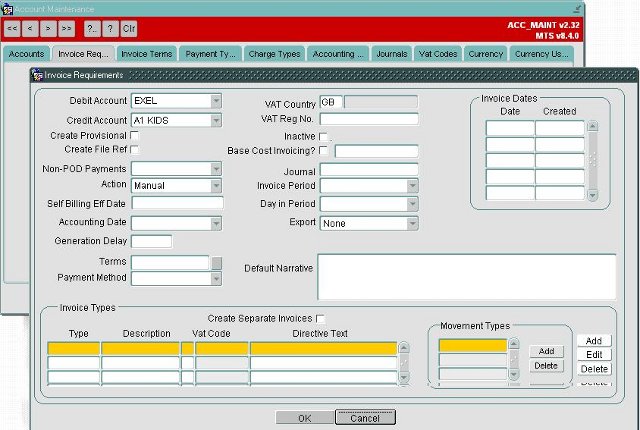
Invoices
TMS has functionality that allows the user to cumulate all payment lines within a selected date range and place onto an invoice. Invoices comprise of payment lines where each payment line will contain details of the specific order. Invoices can be generated weekly or monthly or to a specific date schedule.
To access the invoices screen, go to C-TMS Modules, Finance, Invoices.
It is possible to view the itemised breakdown of the invoice by double clicking into it and selecting "both".

Invoice Date Ranges
Invoices can be set to be generated on a set frequency as required by the customer - example below:
From: Sunday 00:00
To: Saturday 23:59.
This is a configurable setting within TMS and can be amended in the Accounts maintenance screen - located in C-TMS Modules, Maintenance, Accounts Maintenance.
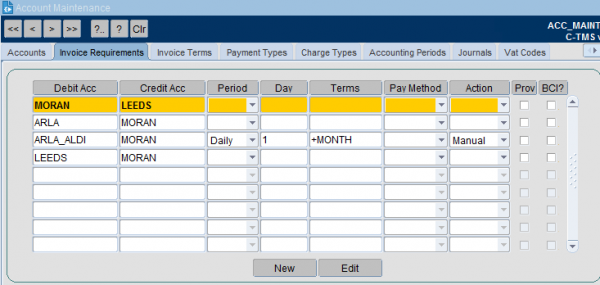
To amend the date range, select the Edit option. You can then amend the Invoice Period and the Day in the Period the invoices are created:
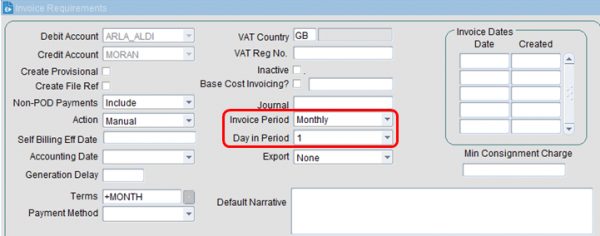
To send an invoice to a customer
Once an invoice has been reviewed, it can be approved and sent across to the customer in the following way:
- Highlight the invoice to be sent
- Once reviewed, set the relevant invoice status from Draft to Approved - this is achieved by right clicking on the line, select Set Status and select Approved.
- Select Exports.

- Select Generate Export
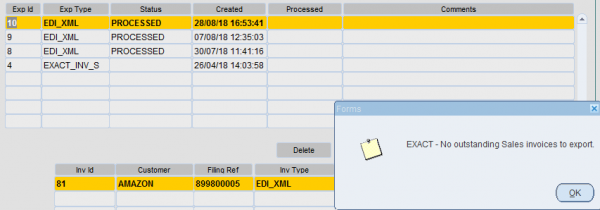
- Select OK. You will see the screen below:
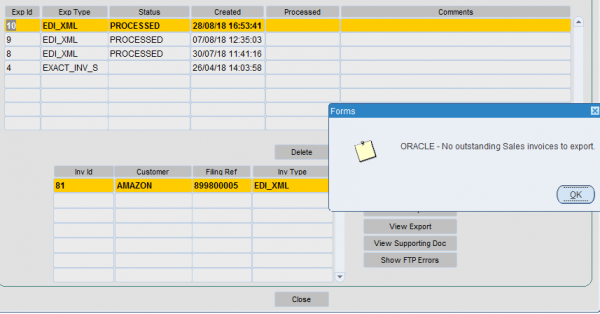
- Select OK.
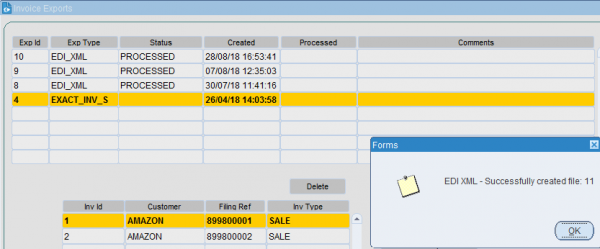
- You will then see the "successfully created file" message as above.
- The next stage is to select the Send Export button - this will set the status to "Processed".
- This is the trigger point that will send the invoice across. The invoice will display as "Processed" - as below.

![]() Note: There is specific setup required beforehand to ensure that the relevant customer will receive the invoice in the required format.
Note: There is specific setup required beforehand to ensure that the relevant customer will receive the invoice in the required format.
If the push of the file fails, users may view the FTP Errors to find out why the extract failed.

From this form, the invoices can be printed or exported to a CSV file.
C-TMS provides the ability to see the savings generated for a particular date range for a particular customer. This can then be exported into a CSV file.
View Export and Supporting Docs
Once an invoice has been generated, it will be displayed first in the top data block. You may then select View Export to see the payments that will be posted when the export is sent. Selecting view will automatically display the header for the selected.
You are also able to view the details of the export, this includes details of the items for which payments have been generated. When selecting the View Supporting Doc button, the following screen is displayed, You enter the export id and select a customer, to view the payment details.
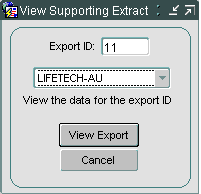
The support documents will run for a single customer, where the customer has at least one invoice included in the export. If the customer selected does not have an invoice in the export, the supporting doc will be blank.
Profit & Loss
The oracle report suite (Reporting & Extract Suite) allows data to be extracted into CSV. A Profit and Loss report can be created. Once created, this can be run daily, weekly or monthly and will show all inbound and outbound payments within a specific time frame.
By amending the Credit account, you can extract costs and then revenue separately.
The criteria below shows all revenue payments allowing the data to be totalled in CSV format.
View invoice details
It is possible to view the itemised breakdown of the invoice by double clicking into it and selecting "Both"

Invoice Generation and Printing
- To generate a new invoice for a new date range, click Generate.
- Payment Lines can only be assigned to invoices in a status of "Draft"
- Once a previous invoice has been reviewed and all relevant payment lines are included, the status should be changed to "approved" as part of the exporting to customer process.
New Invoice Creation:
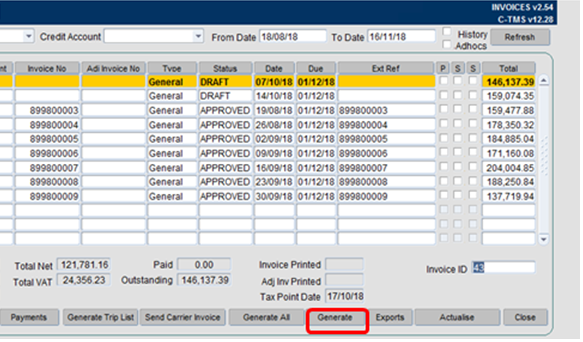
Set the debit and credit accounts appropriately:
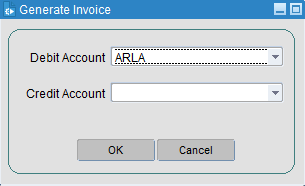
This invoice will then appear in the invoices screen with a status of "Draft". All relevant payment lines in a status of "A" (Actualised) will automatically be added to the invoice.
Printing of an Invoice
To print of an Invoice to review or to keep a manual copy:
- Highlight the associated invoice
- Right click and select Print -> Invoice
 Note: You can send the Invoice to a CSV Spreadsheet format by right-clicking and selecting Export Invoice.
Note: You can send the Invoice to a CSV Spreadsheet format by right-clicking and selecting Export Invoice.

- Select Print
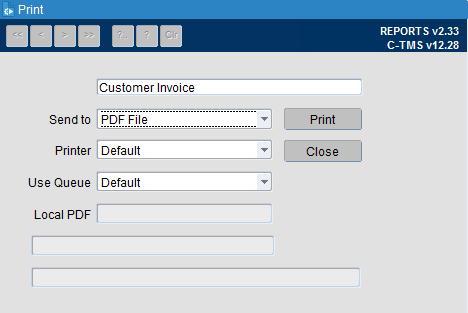
An example output is illustrated below:
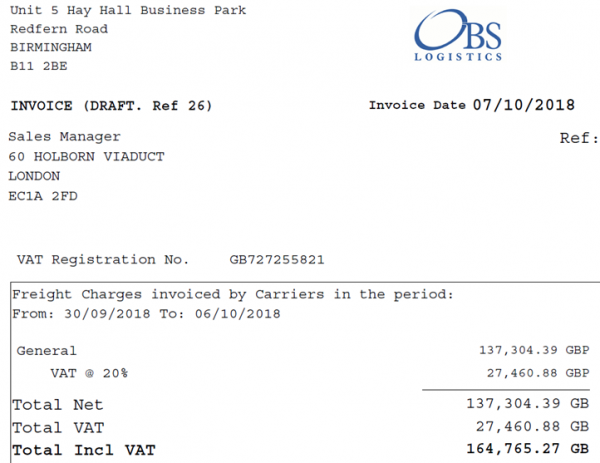
An itemised breakdown of the associated invoice is also displayed:

Carrier Billing
C-TMS also allows a Carrier to be invoiced using a "Self Bill" mechanism - this process involves sending a list of trips and payments to the carrier to validate. The carrier reports any discrepancies and once all issue are resolved a Carrier invoice is sent to the carrier. The purpose of this is to speed up the process of paying the carrier and reducing the amount of time spent resolving issues with and de-briefing carrier invoices.
Further Configuration
The following system parameters affect this functionality:
| Parameter | Description | Level |
|---|---|---|
| OF_CURRENCY_CODE | Oracle Financial Currency Code | SYSTEM |
| OF_FILE_ARCHIVE | Oracle financials archive file path. | SYSTEM |
| OF_FILE_NAME_SECTION2 | Stores the name of section 2 on the OF filename | SYSTEM |
| OF_FILE_PATH | Oracle financials file path. | SYSTEM |
| OF_FTP_DESTINATION_DIRECTORY | Oracle Financials FTP Dir | COST_CENTRE |
| OF_FTP_DESTINATION_DIRECTORY | Oracle Financials FTP Dir | SYSTEM |
| OF_FTP_DESTINATION_IP_ADDRESS | Oracle Financials FTP IP | SYSTEM |
| OF_FTP_DESTINATION_IP_ADDRESS | Oracle Financials FTP IP | COST_CENTRE |
| OF_FTP_DESTINATION_PASSWORD | Oracle Financials FTP Password | COST_CENTRE |
| OF_FTP_DESTINATION_PASSWORD | Oracle Financials FTP Password | SYSTEM |
| OF_FTP_DESTINATION_PORT | Oracle Financials FTP Port | SYSTEM |
| OF_FTP_DESTINATION_PORT | Oracle Financials FTP Port | COST_CENTRE |
| OF_FTP_DESTINATION_USERNAME | Oracle Financials FTP User | SYSTEM |
| OF_FTP_DESTINATION_USERNAME | Oracle Financials FTP User | COST_CENTRE |
| OF_FTP_DEST_DTL_DIRECTORY | Cargowise Details directory | COST_CENTRE |
| OF_FTP_DEST_DTL_PASSWORD | Cargowise Details password | COST_CENTRE |
| OF_FTP_DEST_DTL_USERNAME | Cargowise Details username | COST_CENTRE |
| OF_IF_DTL | Oracle Financial IF DTL | SYSTEM |
| OF_IF_FTR | Oracle Financial IF FTR | SYSTEM |
| OF_IF_HDR | Oracle Financial IF HDR | SYSTEM |
| OF_JRNL_ENTRY_SOURCE_NAME | Oracle Financial Journal Entry Source Name | SYSTEM |
| OF_ORIGID | Stores the name of ORIGID | SYSTEM |
| OF_SECTION2 | Stores the name of section 2 on the OF filename | SYSTEM |
| OF_SETTINGS | Controls if Oracle Financial settings are required for 11i and R12 | SYSTEM |
| OF_SOURCE_SYSTEM_CODE | Oracle Financial System Code | SYSTEM |
